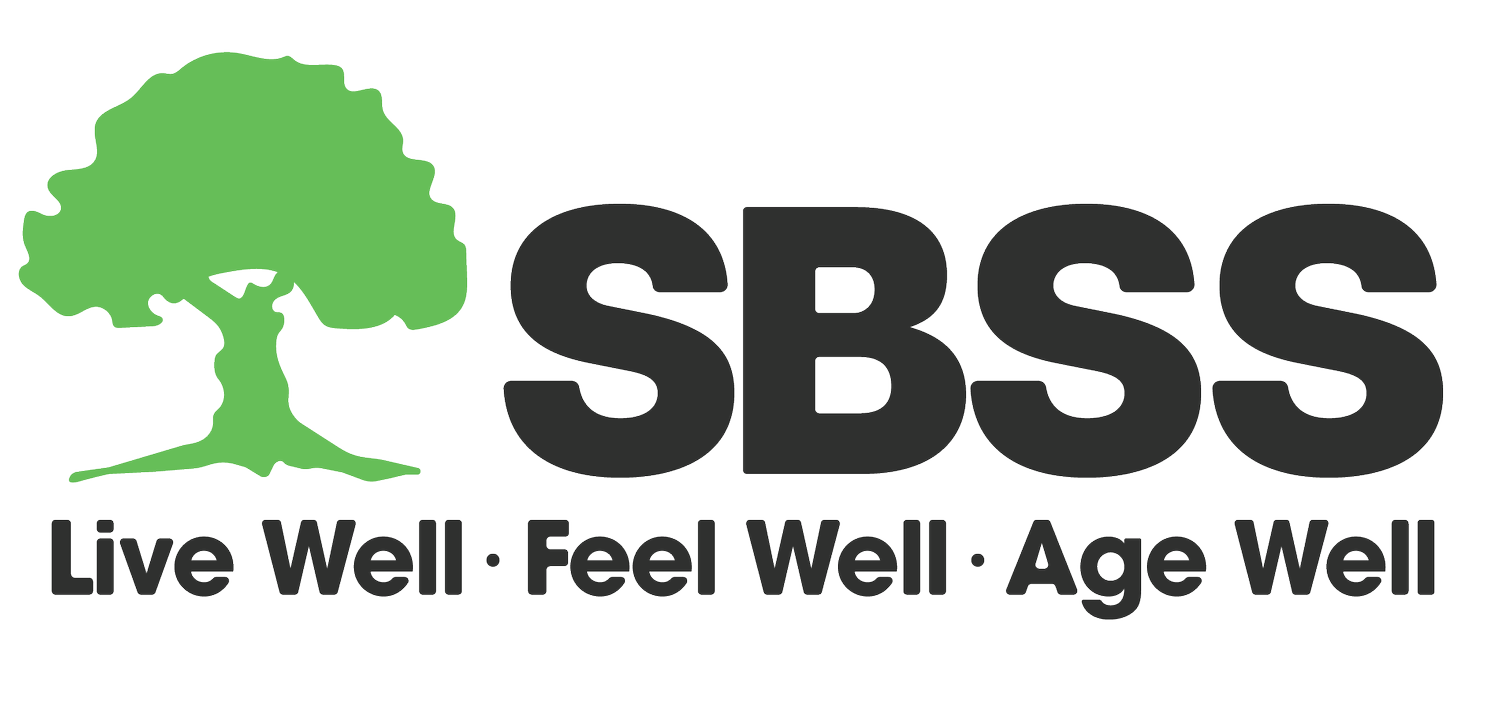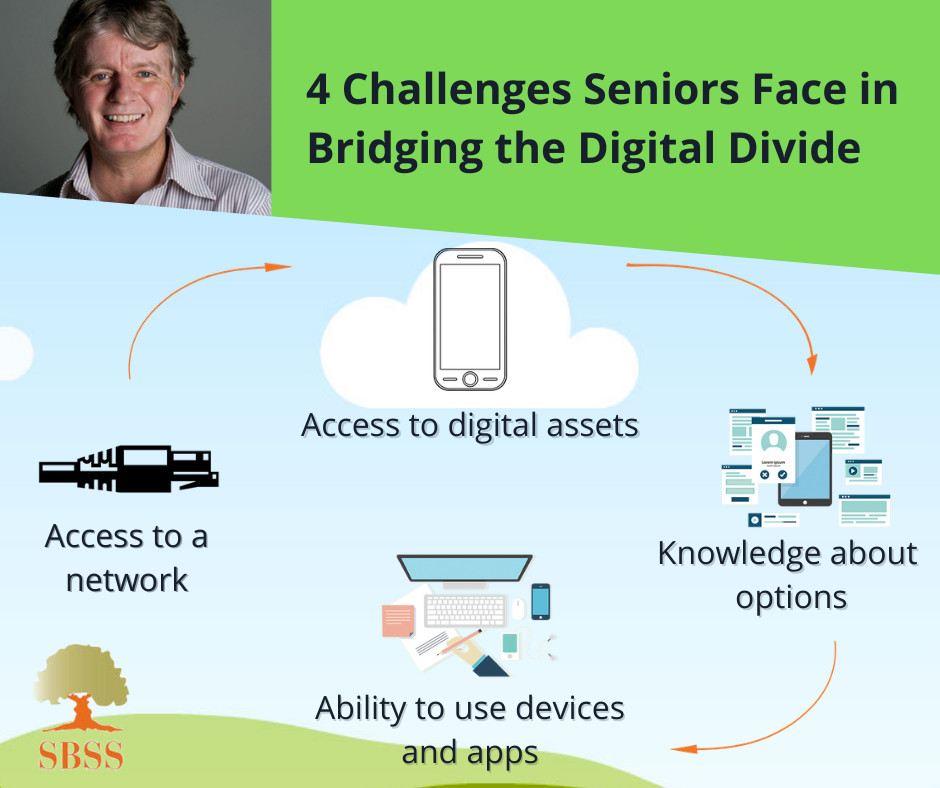Guest Post by Jon Warner, SBSS Board of Directors and CEO of Silver Moonshots
We talk a lot about the so-called ‘digital divide’ or the population excluded from being able to use modern innovation and technology such as the Internet, Smartphones, Tablets, Smart speakers and other devices. However, this divide comes in 4 ‘flavors’ in my view, as I illustrate in the image at the top of this article.
The first ‘layer’ of assessment for an older adult is to ask if he or she is the able to connect at all, the second is do they have the hardware or device, the third layer is are they aware of the options they could or should use or find helpful and finally, the fourth is do they have the training and competence to use the device or applications on it well? We need a coherent strategy to address all 4 of these and in this brief article I want to dig into these 4 questions a little further, so that we can better appreciate the challenges and consider our options.
1. Can the older adult connect at all?
Many older adults with limited financial resources may not be able to afford to put the Internet in their home (after all, almost half of seniors living alone in the US and almost 1 in 4 of those in two-person households are unable to afford basic necessities). Such older adults, with limited means, are clearly at greater risk of social isolation, forgoing necessary medical care at times (as technologies like telehealth may not be useable, for instance) and in some cases even going without food or other necessary items. If an older adult has a smart phone (around 42% of people 65 and over according to Pew research) they can perhaps connect via 4G but research suggests that even many of these don’t use this functionality and if they do it is often in a very limited way (Pew suggests the dominant use for it is social media and ‘facetime’ type connections).
2. Do older adults own and understanding the hardware or device?
Assuming an older adult does have Internet connectivity they still need at least one device that connects to it. As we said above the most common device is a smartphone, followed by a tablet and closely followed by a smart speaker (Alexa or Google Home, for instance) with wrist bands (like an Apple watch or a Fitbit) and other ‘wearable’ devices a distance last. But these devices need not only to be connected but to be understood in terms of what is possible. For example, Smartphone apps are used by 75% of younger adults but this falls to less than 25% for adults of 65 and over. Similarly, Smart speaker use, when these are owned, was over 80% in a March 2020 study by Amazon, but when they looked at the over 65 population, this number fell in half (and even then, the uses for it were much more limited, with less than 20% of the 65+ population knowing that they could order online products or listen to a favorite radio station, etc).
In addition to not understanding what is possible in functional terms, research suggests that as much as 90% of older adults say they struggle to operate their devices competently. This may be as simple as reconnecting it when it loses internet connectivity, changing volume, or changing basic settings (not to mention seeing the controls, which are often very small!).
3. Are older adults aware of the options they could or should use or find helpful?
Because many older adults own a phone (which may be a land line or a simple old-fashioned mobile phone) as we have already mentioned, an upgrade to a smartphone is often the first thought when it comes to upgrading or gaining access to online products and services (and if this goes well, and they can afford it, a tablet or smart speaker may also be purchased).
However, all of these devices need to be navigated to understand how they can be operated and made useful. Often a more ‘tech-savvy’ individual (often a younger relative) may be able to show a senior how to use their devices, but research suggests that even where this is available it’s for less than 15 minutes. This means that most older adults remain unaware of useful commands, apps that they can download and use and web sites that are both useful and interesting and may well help them considerably in their daily life in a multitude of different ways. One significant example here is paying bills and transferring money without ever having to leave home. This is routine for younger people but less than 10% of the 65+ population do this, in practice.
4. Do older adults have the training/competence to use the device or applications on it well?
Even when older adults have local/home-based Internet connectivity and one or more so-called smart devices, this does not mean that they know how to use them or use as much as they might. Although Apple device stores offer some in-store workshops (closed for much of the COVID19 pandemic, of course) these are rarely sufficient to cover more than a few basics. As with most technology, people need time to learn the basics and then progress in their own time to learn how to use various functions. For older adults, the often takes much longer and they need to practice before moving on.
For example, a relatively simple task like taking a photograph may take 30-45 minutes of instruction and more when it is to be ‘posted’ on social media or edited to improve the quality. For younger individuals this might be achieved by basic experimentation or by watching videos on ‘YouTube’ but for many older adults they can get quickly lost or need a course on accessing, searching and watching You Tube first!
Why does it matter so much?
It is estimated that 30% of all adults of 65 or greater do not have any access to the internet and smart devices and another 25% use them in highly rudimentary ways. This excludes both of these populations (either fully or partially) from being able to gain the benefit of many modern-world conveniences including ordering products online (e-commerce), choosing and getting food delivered online (Smartshopping), using an online map to get to a new address (GIS), quickly getting a person to do an errand (SmartTasks), taking an online education course (MOOCs), contacting a local private ride service (Rideshare), seeing online nurse or doctor from home (Telemedicine) and many other benefits. For the lucky few who have helpful friends and relatives, or where they live in a senior community, they may be able to get the help they need, but for the vast majority this may not be available, and they simply miss out.
This matters, of course, because it can make life easier for them and others and help to reduce worry or anxiety (and ultimately keep people happier and healthier for longer). As a simple example, older adults may wait to see a doctor or dentist until they can get a ride from a friend or relative or not go at all (and perhaps become ill). This easily overcome with Rideshare apps and knowing how to use it.
So, what can we do differently in the future?
Every one of the above steps is a progressive path that needs to be considered carefully and followed step-by-step if we are to help older adults to cross the digital divide successfully. A few older adults are getting help with some or, in a few cases, all of this, but far too many are not, and we all need to step in to help, if we can. This begins with greater awareness of the issues and asking questions about who we know are struggling. We can then either make a personal effort to help (offering to volunteer, for example) or seek to influence others to do so.
This includes what are often several local nonprofits (like St Barnabas that offer tech education, training and individual assistance of all kinds), finding out what government services are on offer (such as programs often offered by local libraries, for instance) or even for profit organizations that will often give discounts to seniors for help and training.
Most importantly to me, we need to advocate more strongly to local, State and National Government to provide resources to the older adult community to access and use modern technology that helps them. Many countries already have subsidized or in some cases offered free broadband home internet installation for their retired persons, for instance, and this would be something to aim for in the near future for every older adult across the US too.
Jon Warner is CEO of Silver Moonshots-www.SilverMoonshots.org, a research and support organization for enterprises interested in the 50+ older adult markets with its own aging focused virtual accelerator. He is also Chapter Ambassador for Aging 2.0 and on the Board of St Barnabas Senior Services (SBSS), in Los Angeles, California.

